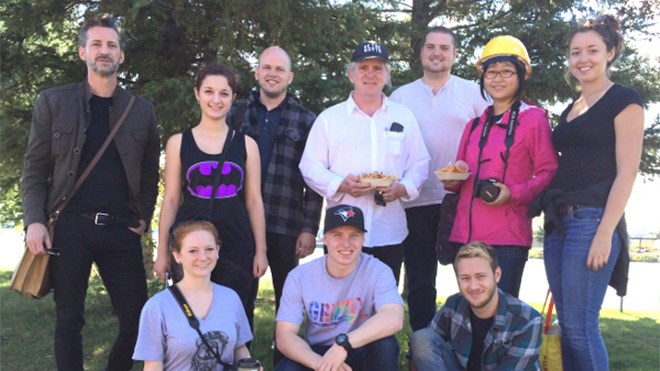Fifty-two students from the first new architecture school to open in Canada in the last 40 years are helping move the Mill Market to its permanent home in the old St. Marys Paper board mill at Mill Square.
"We're working with Justus Veldman on his development," said Thomas Strickland, assistant professor at Laurentian School of Architecture in Sudbury.
"The plan is to study his buildings and in particular the board mill building. The market will hopefully be moving there very soon. Our project is to work with Justus on studying how this market works, how it integrates with the community and how it can translate some of that success into the new building."
The small army of architecture students descended on the Sault this past weekend, studying Veldman's buildings and conducting interviews and historical research.
"We'll be going back to Sudbury to the school for about four weeks, where we'll be developing design strategies and ideas from this information," said Strickland.
52 design strategies
The students will return from Oct. 30 to Nov. 7, erecting a kiosk that will be used to study the relationship between vendor and customers.
The students will then develop 52 design strategies for moving Mill Market from its temporary home in the old municipal fish hatchery, to Mill Square.
Strickland got his PhD at McGill University. He's taught in the Azrieli School of Architecture and Urbanism at Carleton University and at Concordia University's faculty of art history.
Joning Strickland in the Sault this past weekend was Terrance Galvin, founding director of Laurentian's new architectural school.
Galvin formerly headed Dalhousie University's School of Architecture and has served on the board of the Canadian Collegiate University Schools of Architecture (CCUSA) and the Canadian Architectural Certification Board - Conseil canadien de certification en architecture (CACB-CCCA).
Displaced Sudbury's farmer's market
Interestingly, the new Laurentian architecture school has displaced Sudbury's farmer's market, incorporating the old market building into its downtown campus.
The Mill Market project is just part of what's expected to be a long-term relationship between Laurentian School of Architecture and Veldman.
"This is the first stage," Strickland told SooToday.
"The plan is for us to be involved with the development for a number of years. We'll be working with him as the whole project moves forward."
Laurentian students work on real projects
"We've developed a kind of long-term relationship with him, which is great for the students because they actually get to work on real projects, to connect with real community rather than some made-up community.
Veldman is helping support the school by providing a place for the students to stay while in the Sault.
He's also providing building materials to the student project.
"As a school, we're really interested in the idea of having students work on real projects," Strickland said.
"There's a tradition in architecture school where there's an isolation within the studio and they work on abstract ideas. Abstract projects. We want them in the community, working on real stuff. What's it like to work with a real client?"
It will be up to Veldman whether to proceed with any of the ideas forwarded in the student submissions.
"We are going to come up with 52 proposals - 52 possible options. At that point we will be talking to him about those options. If they're going to move forward with it, then they'll have to engage a real architect."
